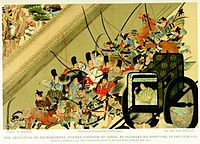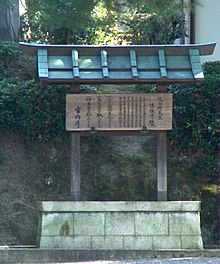Emperor Go-Shirakawa
[1] However, it is broadly acknowledged that by politically outmaneuvering his opponents, he attained greater influence and power than the diminished authority of the emperor's position during this period would otherwise allow.[2] He was de facto the last true emperor, before the shogun became the actual head of the country after Go-Shirakawa's death in 1192 until the Meiji Restoration in 1868.Though, according to Gukansho, Bifukumon-in also suggested her daughter Imperial Princess Akiko, Heian society was fundamentally opposed to the idea of a female ruler.[6] Soon afterwards, the Hōgen Rebellion broke out – Yorinaga had mustered several hundred warriors to try to press Sutoku's claim and usurp Go-Shirakawa's title.Given that Sutoku was overthrown by the military clans and Go-Shirakawa, his position cannot truly be considered to have been secure, Sansom argues, and so the Hōgen Rebellion represents the end of the insei system.This meant that in 1169 (Kaō 1, 6th month) Emperor Go-Shirakawa entered the Buddhist priesthood at the age of 42 – he felt he could no longer control Kiyomori.In 1183 the army of Minamoto no Yoshinaka entered the capital, allowing for Go-Shirakawa's re-entry into the city – he had made a pilgrimage to various shrines, accompanied by armed monks, in order to avoid capture by the Taira.Go-Shirakawa then issued a mandate for Yoshinaka to join with Minamoto no Yukiie in "destroying Munemori and his army", as well as the entire Taira clan.[12] Furthermore, he was also criticized for excessively patronizing literature and religion, being an avid collector of imayo poetry since his youth, with these poems often being focused on Buddhist themes.



Emperor of JapanEnthronementHeian-kyōFujiwara no KinshiEmperor NijōPrincess SukekoPrincess ShikishiPrince MochihitoEmperor TakakuraPosthumous nameImperial House of JapanEmperor TobaFujiwara no Tamakode jure1155 through 1158Hōgen RebellionPosthumously, this 12th-century sovereign was namedEmperor Shirakawaera nameKyūjuHōgende factotrue emperorshogunMeiji RestorationEmperor KonoeSutokuPrince MorihitoGukanshoBifukumon-inFujiwara no YorinagaFujiwara no TadamichiCloistered Emperor TobaMinamotoMinamoto no YoshitomoTaira no KiyomoriGeorge SansomHeiji RebellionRokujōTakakuraAntokuGo-TobaKiyomoriFujiwara no MotofusaShigemoricoup d'etatShishigatani incidentGenpei WarMinamoto no YorimasaMinamoto no YoritomoMinamoto no YoshinakaMinamoto no YukiieImperial RegaliaMinamoto no NoriyoriMinamoto no YoshitsuneBattle of Ichi-no-TaniBattle of Dan-no-uraKenkyūimayo poetryBuddhistTodai-jiwarrior monksChrysanthemum ThroneFujiwara KinshiEmperor HorikawaFujiwara no KenshiList of Emperors of JapanImperial cultGoogle BooksEmperor TenjiYōzeiFushimiEmperor Go-MurakamiEmperor JomeiPonsonby-Fane, Richard Arthur BrabazonTitsingh, Isaac.Nihon Odai IchiranVarley, H. Paul.Emperors of JapanJōmonSuizeiKōshōKōreiKōgenSuininKeikōChūaiJingūYamatoNintokuRichūHanzeiIngyōYūryakuSeineiKenzōNinkenBuretsuKeitaiKinmeiBidatsuYōmeiSushunKōgyokuKōtokuSaimeiKōbunGenmeiGenshōShōmuKōkenJunninShōtokuKōninHeizeiNinmyōMontokuKōkōSuzakuMurakamiReizeiEn'yūIchijōSanjōGo-IchijōGo-Suzaku